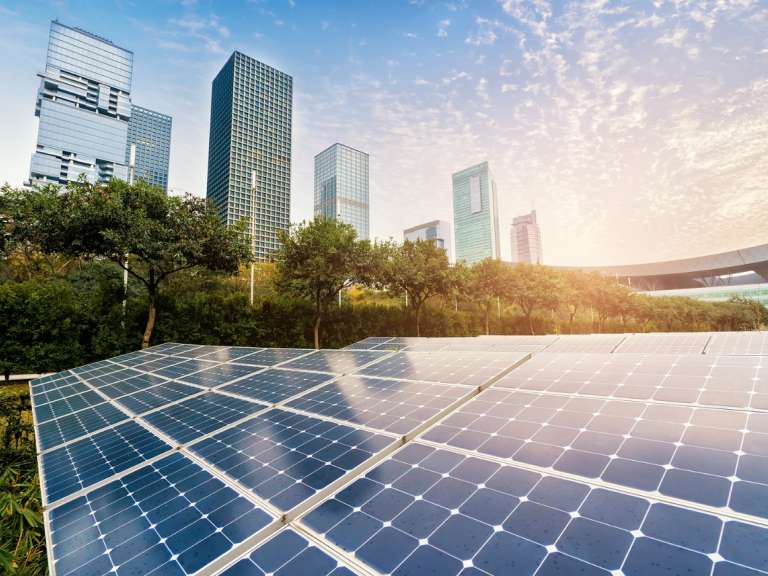Despite the US withdrawal from the Paris Agreement on climate change, cities across the nation are committed to upholding the agreement's principles. Nearly 70 mayors signed the Chicago Climate Charter, and more than 230 US mayors jointly wrote the Environmental Protection Agency to oppose the repeal of the Clean Power Plan. Worldwide, cities are also financing energy projects to reduce greenhouse gas emissions, mitigate climate change, and build the infrastructure for a sustainable society.
With expanding populations, urban areas are more vulnerable than ever to rising sea levels, damaging storms, and scorching heatwaves. And while their leaders show the political will to ensure a sustainable future for their residents, they also need the financial means to support that future.
A Starting Place: Conventional Financing Mechanisms
"A lack of access to finance is a key obstacle to delivering resilient, livable, and climate-safe cities," says Eduardo Paes, mayor of Rio de Janeiro and chairman of C40 Cities, in his paper Finance Systems for Sustainable Cities.
Innovation in technology is a must to develop sustainable and efficient architecture and provide the connections for the smart cities of the future. But also vital is financing energy projects. Conventional means include taxes, bonds, and pricing and trading schemes. Most cities raise revenues from taxes on property, as well as goods and services, to support a variety of public services. Green municipal bonds can also be a mainstay to fund environmental projects. And cities—at least those with decent credit in developing nations—borrow funds from sources that range from international financial institutions to climate funds and private equity firms.
Also in use are carbon pricing and trading schemes to lower greenhouse gas emissions. These act as an incentive to suppress emissions by encouraging those who produce less than their permitted emissions to sell their allotment to those who use more. Charges and levies to modify individual and corporate behavior can also come into play. For example, fees on urban infrastructure such as toll roads or parking lots can encourage commuters to leave their cars at home and take public transit. And developers in new areas may pay levies to ensure they integrate climate-friendly measures.
New Possibilities: Innovative Financing Options
Lesser-known financing schemes can prove valuable, too. For example, tax increment financing uses a percentage of future municipal property tax revenues to develop blighted areas. City government departments must first agree to hold property taxes at the current level. The city spends funds on infrastructure projects, attracting investors and increasing property values, which leads to higher property tax revenues. Those revenues repay the public-private investment and go to continuing improvements in the district. But there can be a downside: The rising values may lead to gentrification and drive away original residents.
Intracting (internal contracting) can help finance energy-saving measures in public buildings. Intracting requires an initial political decision to create a fund for financing energy projects. Money saved through energy efficiency measures flows back into a dedicated budget line until the investments have been paid off. A service provider determines the energy-saving measures to implement, calculates investment cost and achievable savings, estimates economic efficiency, and arrives at a payback period. Once paid off, properties continue to benefit from lower energy bills.
Energy-performance contracting relies on a public-private partnership to promote sustainability. City governments contract with an energy service company (ESCO) to install energy-efficiency, renewable-energy, and distributed-generation measures, often for residential and public housing projects. The reduced energy bills help pay back the ESCO, usually over five to 15 years. But the revenues received are based on the performance experienced: Lower energy savings mean lower paybacks.
Crowdfunding leapfrogs the traditional private-capital market as a funding source. Instead, citizens invest their own money in a proposed project—for example, a solar roof on a school or a solar farm. The crowdfunded portion may be combined with private investment. And unlike crowdfunding by platforms like Kickstarter, crowdfunding for energy projects can be debt funding that pays back principal plus interest.
Utility Support: Unexpected Alternatives
Sometimes cities may be pleasantly surprised when utilities make it easy for them to create infrastructure that mitigates climate change. Many cities want to develop microgrids—sections of the larger grid that rely on renewables such as rooftop solar and batteries. Ideally microgrids could be isolated from the main electrical infrastructure, if desired.
However, the utility that owns the electrical infrastructure has a monopoly on it. That means microgrids either have to be completely behind the meter of a single customer—for example, a university or military base—or under the control of the utility itself. But in Illinois, ComEd has developed a tariff to allow third parties to create and manage microgrids with the option of using ComEd's grid, Renewable Energy World reports.
Cities have recognized that the time to act to combat climate change is now. Their role is vital in protecting the urban residents of today and the billions joining them in the decades to come. Municipalities can shape how a large swath of the world deals with the environmental threats that lie ahead. With the right financial resources, cities can become leaders of transformative change in energy generation.
